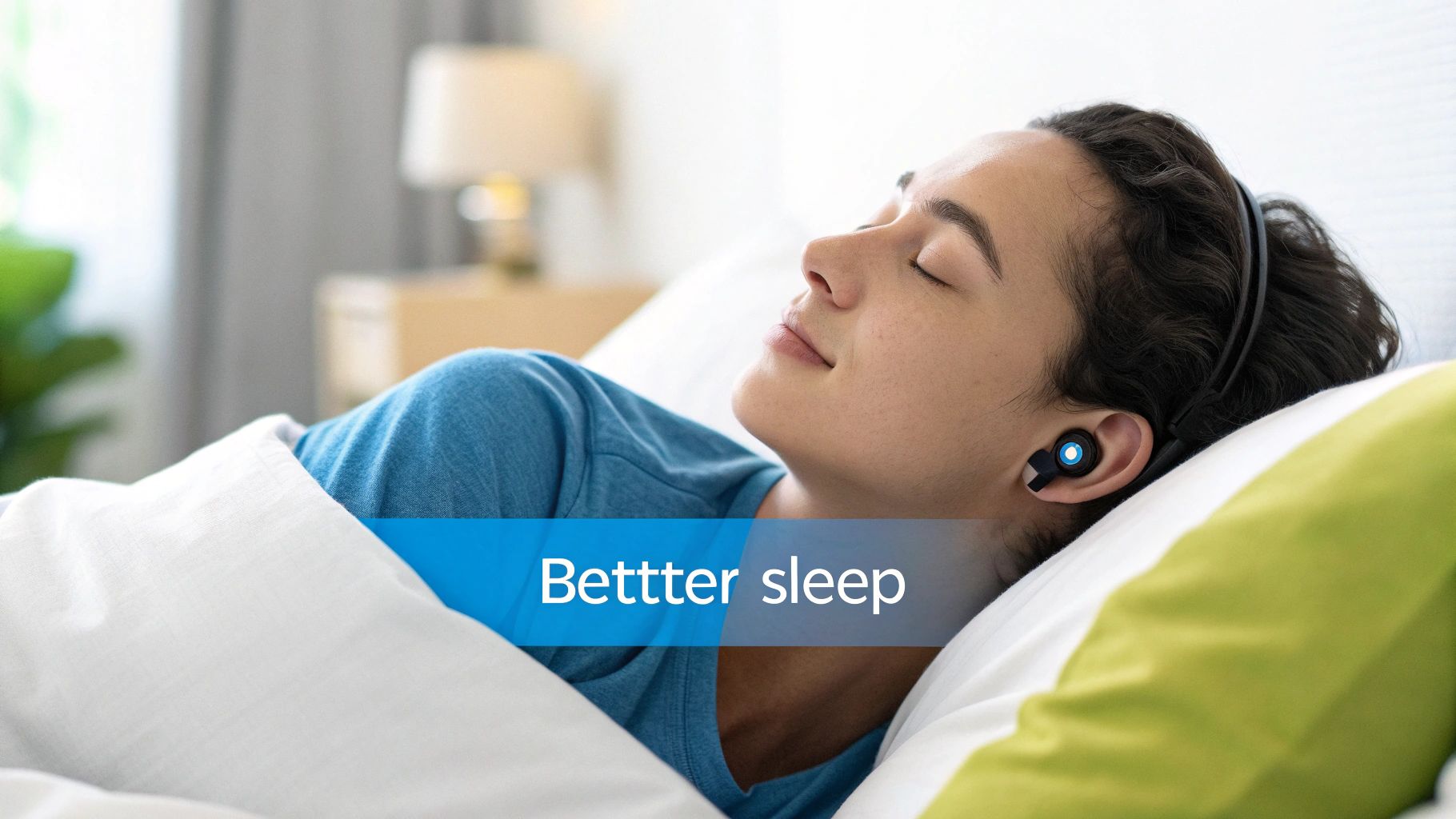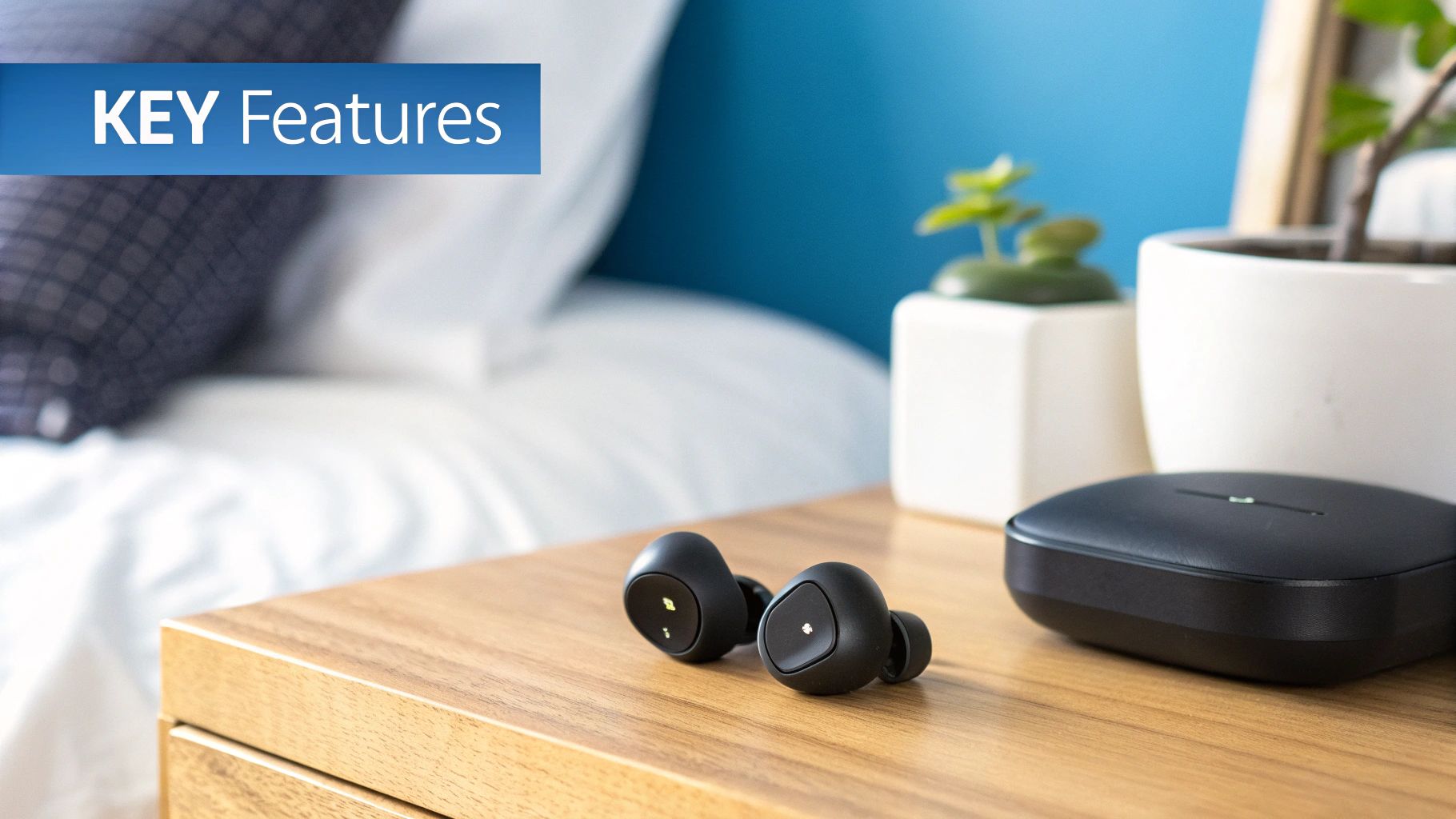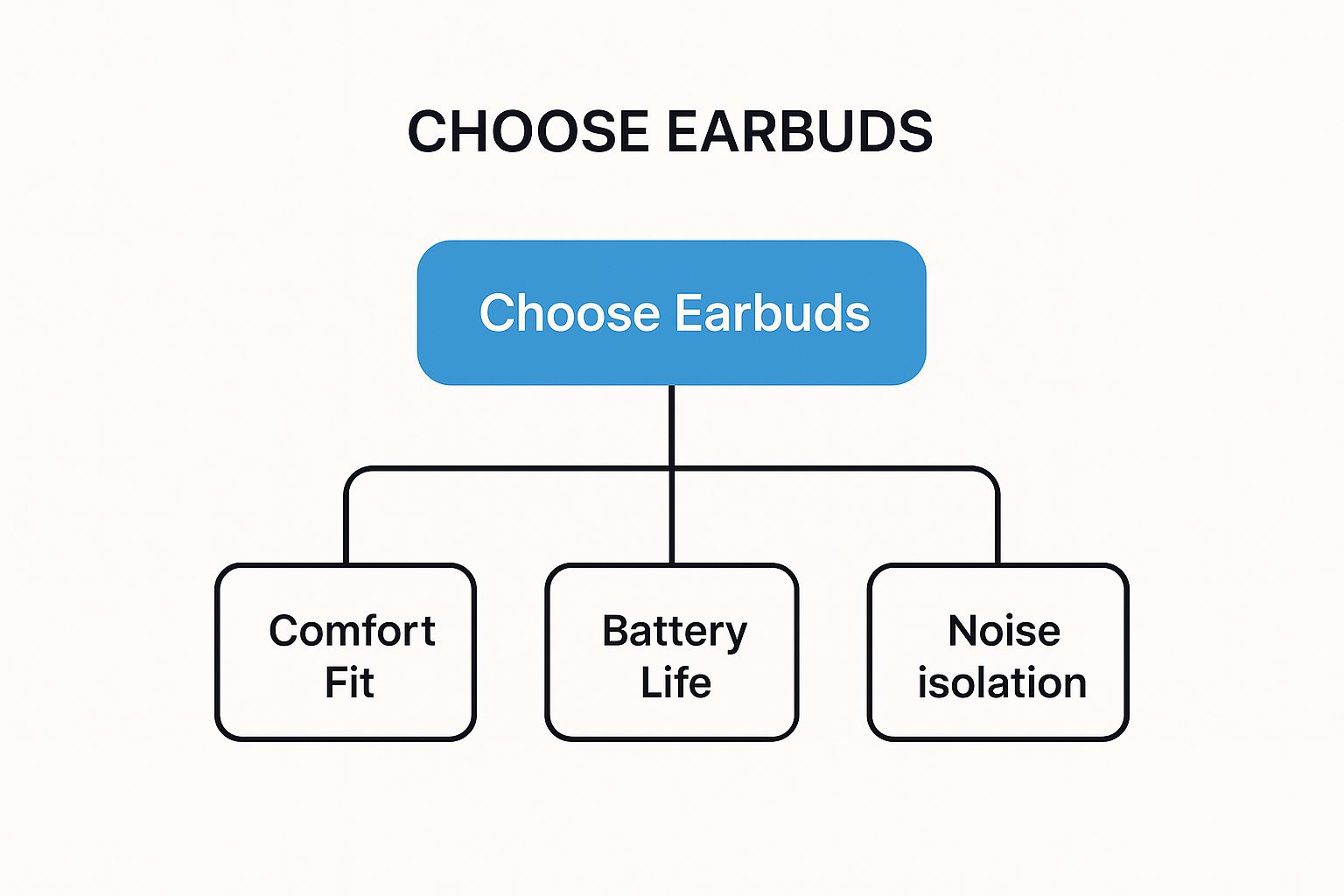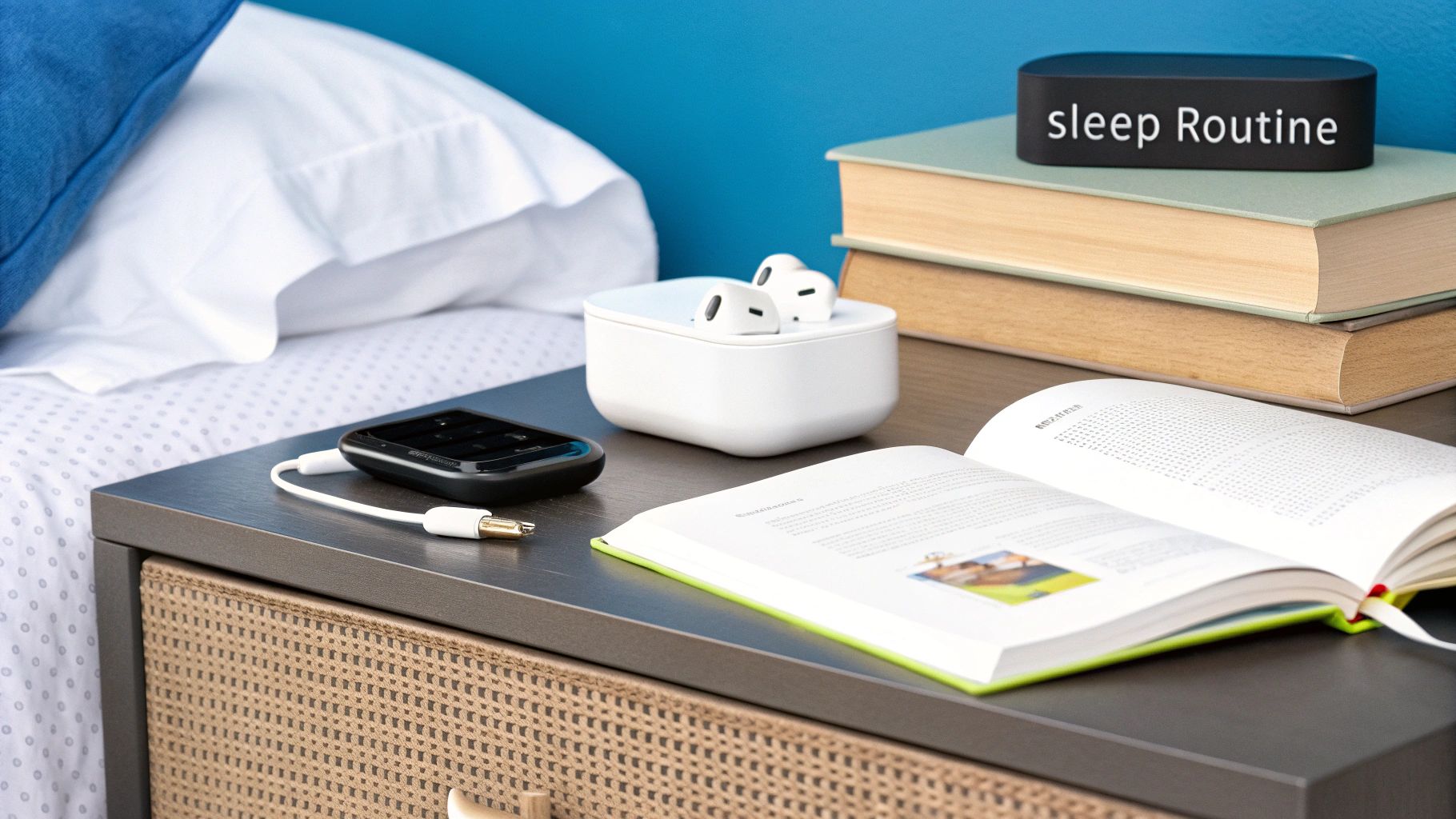When you're trying to get a good night's sleep, blocking out the world is often the first and biggest hurdle. That's where specialized earbuds you can sleep in come into play. These aren't your typical bulky headphones or the hard plastic buds you use for a workout; they're built from the ground up for overnight comfort and blocking out noise, making them a fantastic tool for getting some real rest.
Your Guide to a Quieter Night
Finding true quiet in our noisy world can feel like a losing battle. Whether it's a partner’s snoring, the hum of city traffic, or the neighbor's late-night TV, countless sounds can shatter the peace you need for deep, restorative sleep. This guide is all about a solution designed specifically for this problem: sleep earbuds.
It helps to think of them not as tiny speakers, but as blackout curtains for your ears. Their main job isn't to blast your favorite album with perfect clarity. Instead, they're designed to do one thing exceptionally well—help you sleep soundly all night long.
What Makes Sleep Earbuds Different?
Unlike the earbuds you pop in at the gym or on your commute, sleep-focused models are built around a completely different set of priorities. The whole design philosophy shifts from active listening to passive comfort. The real goal is to make you forget you're even wearing them.
Here’s what really sets them apart:
- Low-Profile Design: They’re made to be incredibly small and are often crafted from soft, flexible silicone. This is crucial for avoiding painful pressure on your ear canal, especially if you're a side sleeper.
- Sound Masking Focus: The audio is specifically tuned for soothing, consistent sounds like white noise, gentle rain, or ambient soundscapes. These sounds are far more effective at drowning out external noises than music is.
- All-Night Comfort: The materials and shapes are carefully chosen to prevent the irritation or soreness that's so common after wearing standard earbuds for hours on end.
These aren't just smaller versions of regular earbuds. They're a purpose-built category of audio gear, where comfort and the ability to create a steady, calming sound bubble are the only things that matter.
Once you get these core differences, it’s easy to see why grabbing your everyday earbuds at bedtime usually ends in frustration. True sleep earbuds tackle these issues head-on, offering a clear path to a quieter, more peaceful night.
Why Regular Earbuds Fail for Sleep

If you've ever tried falling asleep with standard earbuds, you know the drill. You get yourself into a comfortable position, pop them in, and start to drift off... only to be jolted awake by a sharp jab in your ear the second you roll onto your side. It’s a frustratingly common experience that points to a simple truth: your everyday earbuds were never meant for the unique pressures of sleep.
Think of it like trying to run a marathon in a pair of dress shoes. Sure, they’ll get you from the car to the office, but they're completely wrong for the demands of a long run. Regular earbuds are the dress shoes of the sleep world; they're built for active, upright listening, not for being squashed against a pillow for hours on end.
The Pain of Poor Design
The biggest issue is plain old physical discomfort. Most earbuds are made from hard, unforgiving plastic designed to stay put during a workout or your daily commute. But when you lie on your side, that rigid material creates a painful pressure point right against your ear canal. It’s more than just a minor annoyance—it actively sabotages the very rest you’re trying to get.
And then there’s the problem of fit. Standard earbuds are notorious for falling out in the middle of the night, leaving you fumbling around in your sheets trying to find a lost bud. Each time you have to readjust, you’re pulled out of a light sleep, making it that much harder to reach the deeper, more restorative stages of your sleep cycle.
The core problem is this: traditional earbuds prioritize audio quality for active listening over passive, all-night comfort. Their entire design is a direct obstacle to a peaceful night, especially for the 74% of adults who are side sleepers.
An Audio Mismatch for Rest
It’s not just the physical shape that’s all wrong; the audio is tuned for the wrong activity, too. The earbuds you use for music are engineered to deliver crisp highs and deep, thumping bass, which is great when you want to feel every note of a song. But when your goal is to quiet your mind, that dynamic range can be incredibly distracting.
This is where specialized earbuds you can sleep in are completely different. Their focus is on delivering consistent, soothing soundscapes, not intricate musical detail. The whole point is to create a stable "sound blanket" that masks distracting outside noises.
- Active Listening Audio: Emphasizes a wide frequency range for music, podcasts, and phone calls. The sound is meant to be engaging and detailed.
- Sleep Audio: Focuses on consistent, non-distracting sounds like white noise, pink noise, or gentle ambient tones. The goal is sound masking, not entertainment.
This audio mismatch means that even if you somehow manage to get comfortable, the sound coming from regular earbuds can keep your brain more alert than relaxed. When you add it all up, trying to use them for sleep is a frustrating compromise. They fail on comfort, they fail on fit, and they fail on their sound profile, making a strong case for why a purpose-built device isn't just a luxury—it's a necessary tool for anyone serious about improving their sleep.
The Growing Demand for Sleep Technology

It feels like everyone is chasing a good night's sleep these days, and for good reason. In a world that never seems to quiet down, finding true peace and quiet for deep rest is a real challenge. This isn't just a minor annoyance; it's a major shift in how we think about our health, turning sleep from something that just happens into something we actively work to improve.
The culprits are all around us. For city dwellers, the constant soundtrack of sirens, traffic, and noisy neighbors makes it tough to switch off. On top of that, we're all more aware than ever of just how vital sleep is for our mental and physical well-being. People are no longer willing to just put up with restless nights.
A Market Responding to a Universal Need
This collective search for better rest has kicked off a huge demand for real solutions. People are actively looking for tools to help them reclaim their sleep environment. As a result, the sleep technology market has exploded, growing from a small niche into a major wellness category.
This is exactly where devices like earbuds you can sleep in come into play. They’re a direct answer to a very common problem, offering a practical, tech-driven way to create your own personal sanctuary of sound. Their rising popularity is part of a larger trend toward personalized health tools that fit right into our daily lives.
The numbers don't lie. The global market for sleep earbuds is a perfect example of this boom. Currently valued at around USD 1.5 billion, it's projected to more than double to an estimated USD 3.8 billion. That kind of growth shows a powerful and ongoing demand for better sleep solutions.
More Than Just Earbuds
This push for personal well-being is fueling the entire sleep tech market, including other sleep technology gadgets designed for ultimate comfort and ease. We’re seeing a whole ecosystem of products emerge, from smart mattresses that adjust to your body to advanced trackers that analyze your sleep cycles.
What this all means is that you're not alone in looking for a fix. The industry is hearing the call and responding with smarter, more effective products than ever before. These aren't just gadgets anymore; they're becoming essential tools for modern health, built to tackle the real-world problems that get in the way of a peaceful night.
Essential Features to Look for in Sleep Earbuds
Picking the right earbuds you can sleep in feels a lot like choosing a new mattress. What feels like a dream for one person might be a total nightmare for someone else. The secret is to ignore the flashy marketing and zero in on a few core features that actually impact your rest.
Your checklist should put comfort at the very top, followed closely by real-world needs like battery life and how the earbuds handle noise. It's a lot easier to figure this out when you know what to look for.
This visual breaks down the main things you'll want to consider when making your choice.

As you can see, the sweet spot is where a barely-there fit, all-night battery, and effective sound blocking all come together.
When you're comparing different models, it's helpful to have a clear checklist. This table lays out the most important features, what to look for, and why they're so crucial for getting a good night's sleep.
Key Feature Checklist for Sleep Earbuds
| Feature | What To Look For | Why It Matters For Sleep |
|---|---|---|
| Comfort & Fit | Soft, flexible materials (like silicone), low-profile design that sits flush in your ear. | Prevents painful pressure points, especially for side sleepers. You should barely notice they're there. |
| Sound Technology | Noise masking (using soothing sounds like white noise) is often better than Active Noise Cancelling (ANC). | Noise masking covers up sudden noises without the subtle hiss or pressure that ANC can sometimes create. |
| Battery Life | A minimum of 8-10 hours of continuous playback on a single charge. | Ensures your soundscape lasts the entire night without dying at 3 AM and waking you up. |
| Material | Medical-grade silicone or other hypoallergenic, soft-touch materials. | Reduces the chance of skin irritation or discomfort from wearing them for extended periods overnight. |
Ultimately, the best choice will tick all these boxes, ensuring your earbuds help you sleep instead of becoming another distraction.
Supreme Comfort for Side Sleepers
Comfort isn't just a bonus feature; it's everything. The best sleep earbuds are the ones you forget you're even wearing, especially when you roll over onto your side. Hard plastic models will dig into your ear canal the moment your head hits the pillow, creating a painful pressure point that’s impossible to ignore.
This is why you should look for earbuds made from soft, pliable materials like medical-grade silicone. Their design needs to be incredibly low-profile, sitting flush inside your ear so nothing sticks out. For a deeper dive, our guide on comfortable headphones for sleeping has even more tips.
Noise Masking Over Noise Cancelling
It’s a common mistake to think that active noise cancelling (ANC) is the gold standard for blocking out sounds while you sleep. While ANC is great for a plane or a busy office, it's not always the best for the bedroom. This technology works by creating inverse sound waves to cancel out noise, which can sometimes produce a faint high-frequency hiss or a weird feeling of pressure in your ears.
Noise masking, on the other hand, takes a different approach. It works by playing a consistent, soothing sound—think white noise, a fan, or gentle rain—to create a "sound blanket." This effectively raises the floor of your hearing, making it much harder for your brain to even notice sudden disturbances like a dog barking or a car alarm.
- Noise Masking: Covers disruptive sounds with a constant, calming audio stream. Perfect for sleeping.
- Noise Cancelling: Electronically erases ambient noise. Better suited for daytime use like commuting.
For most sleepers, the steady hum of noise masking is far more effective at keeping you from being jolted awake.
All-Night Battery Life
There's nothing worse than your sleep aid giving up on you in the middle of the night. Suddenly, the silence is broken, and all those noises you were trying to escape come rushing back in. A solid battery isn't just nice to have; it's non-negotiable.
Look for earbuds that promise at least 8-10 hours of continuous playtime from a single charge.
A dead battery at 3 AM defeats the entire purpose of wearing sleep earbuds. Always check the manufacturer's stated battery life and read user reviews to confirm it holds up in real-world conditions.
This ensures your peaceful soundscape will last straight through until your morning alarm, giving you an uninterrupted night of rest. A reliable battery means you can set it, forget it, and just drift off.
The Evolution of Sleep Headphones
The search for the perfect earbuds you can sleep in is just one part of a much bigger story. Honestly, the whole world of sleep audio is moving at lightning speed, blowing past simple in-ear designs. What we're seeing now is a really interesting shift from basic listening gadgets to smart wellness tools that treat sleep like the vital health metric it is.
This whole movement is fueled by a simple truth: a one-size-fits-all approach to sleep just doesn't cut it. While earbuds are a fantastic solution for many of us, some people find way more comfort and better results with different kinds of gear.
Beyond the Bud: New Forms of Sleep Audio
One of the most popular innovations to pop up is the sleep headband. Picture a soft, stretchy fabric band with super-thin, flat speakers tucked inside. These headbands get rid of that "something in my ear" feeling entirely, which makes them a godsend for sensitive sleepers or anyone who just can't get comfortable with traditional buds. They spread out the pressure and keep the speakers lined up with your ears, no matter how much you toss and turn.
Then you have devices that are packing in more than just sound. We're now seeing biometric sensors built right into sleep audio products. These things aren't just for listening anymore; they’re for learning. These advanced headphones can actually track key health data while you rest:
- Heart Rate Variability (HRV): This is a huge indicator of how well your body is recovering and handling stress.
- Sleep Stages: They can tell the difference between light, deep, and REM sleep, giving you the full story of your night.
- Body Movement: By tracking how restless you are, they can help you pinpoint what's disturbing your sleep.
By mixing soothing audio with detailed sleep tracking, these devices are basically becoming your personal, all-in-one sleep coach. They don't just help you drift off—they give you the data you need to really understand and improve your sleep quality over the long haul.
The Future: A Connected Sleep Ecosystem
This blend of audio, comfort, and health tracking is pointing toward a future where sleep headphones are at the very heart of our personal wellness routines. Imagine them connecting seamlessly with your health apps, creating a feedback loop where the sounds you hear are adjusted in real-time based on what your body is doing.
The market for these smarter sleep tools is growing like crazy, which just shows how much people everywhere are starting to prioritize good rest. In fact, the sleep headphones market, currently valued at USD 92 million, is expected to climb to USD 160 million very soon. You can read more about the research behind this growth to see just how big this is getting.
At the end of the day, all these new developments prove the industry isn't just making simple gadgets anymore. These are becoming essential tools for anyone who's serious about taking control of their health, one peaceful night at a time.
What Are People Actually Looking For in Sleep Earbuds?

To find the perfect pair of earbuds you can sleep in, it helps to peek over the shoulder of everyone else who’s on the same hunt. Think of it like this: by looking at what people are typing into Google, we get a clear picture of the problems they’re desperate to solve. It’s a bit of detective work that cuts through the noise and helps you zero in on what really matters.
When you start digging into the data, a couple of major themes pop right out. The term ‘sleep earplugs’ is a huge one, which tells us a lot of people just want simple, comfortable noise-blocking. That’s their main goal. But then you see searches for things like ‘noise cancelling sleep earbuds’ spiking, showing a growing crowd that wants a more high-tech solution to their sleepless nights.
Decoding the Search Terms
These search habits basically split people into two distinct camps. You've got the "block it all out" crew and the "drown it out with something better" group.
-
"Sleep Earplugs" Searchers: These folks are all about passive noise isolation. Their mission is to create a physical barrier against the outside world, usually to combat a snoring partner or the neighbor's late-night TV. For them, it’s all about comfort and a fit that stays put all night.
-
"Noise Cancelling Sleep Earbuds" Searchers: This group wants technology to come to the rescue. They're looking for an active solution, often using something soothing like white noise to mask unpredictable sounds that jolt them awake.
Figuring out which group you belong to—blocking vs. masking—is the first big step. This one distinction makes your search so much easier, helping you filter out the fluff and focus on products built for your specific sleep challenge.
This little peek behind the curtain isn't just for fun; it's a practical roadmap. It confirms that you're not alone in your quest, whether you need total silence or just a blanket of calming sound. It makes you a smarter shopper, ready to find a solution that genuinely works—like the options we cover in our guide to white noise headphones for sleeping.
Frequently Asked Questions About Sleep Earbuds
Even with all the details, you might still have a few questions swirling around about making earbuds you can sleep in a part of your nightly routine. Let's tackle some of the most common ones so you can rest a little easier.
Can You Use Them Every Night?
Absolutely, you can use sleep earbuds every single night—as long as you keep two things in mind: hygiene and safe volume levels.
Think about it: your ears need to breathe. It's a smart move to clean your earbuds regularly to keep moisture and bacteria from building up. Nobody wants an outer ear infection.
On top of that, keep the volume low. The whole point is to gently mask outside noise, not to blast audio directly into your ear canal for eight hours straight. Listening at lower volumes is crucial for preventing noise-induced hearing damage over the long haul. It's all about building a sustainable, healthy habit.
The key is balance. Think of them like any other part of your sleep routine. Consistency is great, but proper care is what makes it a safe and effective long-term solution for better rest.
What Is the Difference Between Noise Blocking and Cancelling?
This is a huge one, and it's a critical distinction when you're trying to sleep.
Passive noise blocking (sometimes called noise isolation) is all about the physical design. A well-fitted earbud creates a seal that physically stops sound waves from getting into your ear, kind of like a high-quality earplug. It's simple, surprisingly effective, and it works on just about every type of sound.
Active Noise Cancelling (ANC), on the other hand, is a bit more high-tech. It uses tiny microphones to listen for ambient sounds and then generates an opposite sound wave to cancel them out. While this is fantastic for steady, droning noises like an airplane engine, it's not so great against sudden, sharp sounds like a dog barking or a door slamming. For sleep, good old-fashioned passive blocking is often the more reliable and consistent choice.
Are There Any Health Considerations?
Of course. The two biggest things to watch out for are your hearing health and ear hygiene.
To protect your hearing, a good rule of thumb is the "60/60 rule"—listening at no more than 60% volume for 60 minutes at a time. But for sleeping, you'll want the volume to be even lower than that. Remember, you're just trying to create a gentle sound buffer.
As for hygiene, just make it a habit to wipe down your earbuds regularly to keep potential ear infections at bay. For a deeper dive into safe listening habits, you can learn more about how to sleep with headphones responsibly. Taking these simple precautions ensures your quest for quiet nights doesn't accidentally create other health issues down the line.
Ready to experience the difference purpose-built sleep audio can make? Explore the ultra-thin, comfortable Bedphones from DubsLabs and create your perfect sleep sanctuary tonight. Find your solution at https://www.dubslabs.com.











































